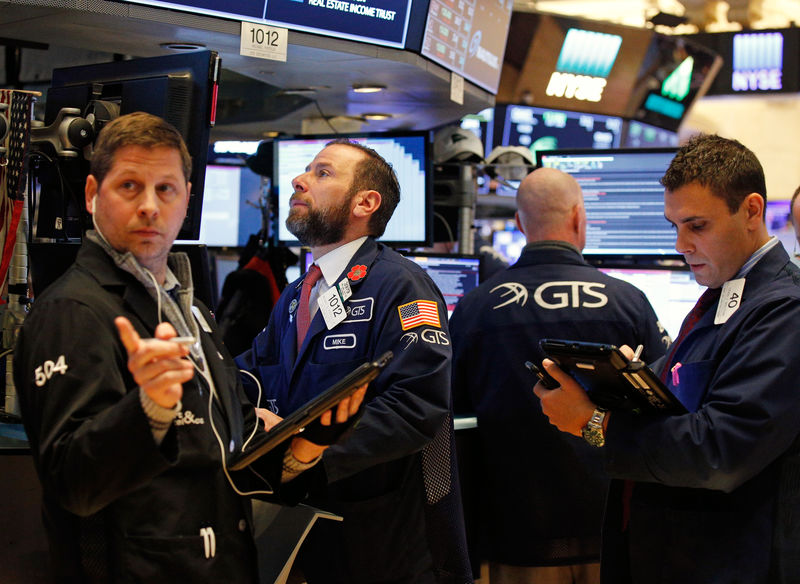 © Reuters. Traders work on the floor of the New York Stock Exchange in New York
© Reuters. Traders work on the floor of the New York Stock Exchange in New YorkBy Mark Miller
CHICAGO (Reuters) – (The opinions expressed here are those of the author, a columnist for Reuters)
Whenever the U.S. stock market nosedives, retirement portfolios seem to get all the attention.
And no doubt about it: the sharp market pullback that began two weeks ago is causing headaches for anyone on the verge of retirement. The big concern is so-called sequence of return risk – that is, the risk that a sharp downturn near the start of retirement will lead to a long-term shortfall in resources available for spending.
But put this in the category of “a good problem to have.” Just over half (52 percent) of U.S. households own retirement accounts and a similar number hold stocks directly or indirectly, according to Federal Reserve data.
And if you are part of that lucky half, your portfolio still is much larger than a year ago – the on Tuesday closed 17.6 percent higher than it did exactly a year earlier and an astonishing 34 percent higher than at the start of 2016.
Moreover, the very economic trends that seem to be worrying Wall Street actually will be good news for many older Americans.
SIDELINED WORKERS OFF THE BENCH
The headline that really put the market in a tailspin was the U.S. government report last Friday on the strength of the labor market. The January jobless rate held steady at 4.1 percent, but payrolls rose by 200,000 and average hourly earnings rose 0.3 percent, following a gain of 0.4 percent in December. (http://reut.rs/2DWz25c)
And for workers over age 55, the “headline” unemployment number last month was just 3 percent. But that figure is much higher when you include older workers who would like a job but gave up looking more than 12 months ago – 8.7 percent, according to analysis of the government figures by the Schwartz Center for Economic Policy Analysis (SCEPA) at the New School.
Late-career employment plays a critical role in determining your retirement security. These typically are the highest-earning years, and they can be important for building savings or earning credits toward higher Social Security or pension payments. And the Great Recession, and the ensuing decade of weak demand for labor, has had a crippling effect on the retirement prospects for millions of Americans.
But a deeper dive by SCEPA into recent jobs data points to something encouraging: the labor market may be getting tight enough to pull long-sidelined older workers back into the job market.
SCEPA reports that 797,000 people ages 55 and older found a job in December, the most recent period for which data is available. Fifty-five percent of them (439,000) came from outside the labor force – in other words, they had not been hunting for work in previous months. The percentage was considerably higher than it has been over the past five years, when it generally hovered around 35 to 40 percent. Another 93,000 who were outside the labor force started looking for work, and are now counted as unemployed. So a total of 532,000 people came “off the bench.”
“These are fairly high numbers,” said Teresa Ghilarducci, a labor economist and SCEPA’s director. “When people who have been out of work for a long time and become discouraged see a tighter labor market, that can inspire them to come back.”
Not that everything is rosy here. Another 422,000 older workers dropped out of the labor force because they lost jobs and either did not try to replace them or gave up on their job searches. Some may have simply retired.
HIGHER INTEREST RATES, INFLATION
The strengthening labor market and tentative signs of wage growth have spooked the stock market because they point toward possible higher inflation. That, in turn, could prompt the Federal Reserve to accelerate its moves to lift interest rates – shifting investment momentum away from stocks and toward bonds.
But this would be good news for retirees, who have suffered through a full decade of Fed monetary policy that has kept interest rates near zero. Many retirees rely on low-risk bonds and other interest-bearing instruments for yield on their savings.
Higher inflation also would help retirees. Social Security’s annual cost-of-living adjustment (COLA) is geared to the Consumer Price Index, and in recent years it has failed to keep up with fast-rising healthcare costs. For many seniors, this year’s 2 percent COLA was consumed entirely by higher Medicare Part B premiums.
Most economists expect inflation to hold steady this year at around 2 percent, and the Medicare trustees forecast that the Part B premium will hold steady in 2019 at $134. That would give Social Security enrollees a real raise in 2019, and it could go higher if inflation jumps beyond the consensus figure.
So yes – the market drop will hurt retirement portfolios – at least in the short term. But it appears that what is bad for Wall Street could be good for Main Street – at least the people there who are retired or getting close to it.
Source: Investing.com




























